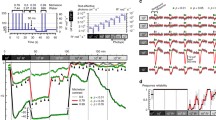Summary
-
1.
The retinae of the mice here employed appear to be very similar to those described by Keeler (1927) as “rodless”.
-
2.
In these retinae the external nuclear layer is very incompletely differentiated (Figs. 2, 6, 7, 8, 9) and in some portions of the retinae where it is best developed it may be seen as a single layer of deeply staining nuclei adjacent to the external limiting membrane. In some places the nuclei form a complete layer, one cell thick; in other places they are relatively far apart; and in still other portions of the same retina these nuclei may not be seen. Nuclei lacking distinctive stainability often occur next to the external limiting membrane and probably represent an early stage in the normal development of the external nuclear layer.
-
3.
The external limiting membrane usually bears on its outer surface, at the place where rods normally occur, a layer of substance somewhat suggestive of nerve fibers. This may be structurally relatively undifferentiated protoplasm which would normally occur as rods, but it does not give the appearance of definite rod buds.
-
4.
Five mice having retinae of this sort were successfully trained to choose white opposite red Hering papers. On the basis of this training they chose green opposite black Hering papers, because of relative brightness (Hopkins 1927), and also a field of white light opposite a similar field of red light under dark room conditions. From these results it is concluded that the mice were not blind, though they could probably not see as well as mice with normal retinae.
-
5.
Attempts were made, with three different methods, to see visual purple in the “rodless” retinae, but without success.
Similar content being viewed by others
Bibliography
Crozier, W. J. and Pincus, G. (1927): Phototropism in young rats. Journ. of Gen. Physiol. 10, 407–417.
Detwiler, S. R. and Laurens, H. (1921): Studies on the retina. Histogenesis of the visual cells in Amblystoma. Journ. of Comp. Neurol. 33, 495–508.
Hopkins, A. E. (1927): Experiments on color vision in mice in relation to the duplicity theory. Zeitschr. f. wiss. Biol., Abt. C: Zeitschr. f. vergl. Physiol. 6, 299–344.
Keeler, C. E. (1927): Rodless retina, an ophthalmic mutation in the house mouse, Mus musculus. Journ. of Exp. Zool. 46, 355–407.
Author information
Authors and Affiliations
Rights and permissions
About this article
Cite this article
Hopkins, A.E. Vision in mice with “rodless” retinae. Z. f. vergl. Physiologie 6, 345–360 (1927). https://doi.org/10.1007/BF00339260
Received:
Issue Date:
DOI: https://doi.org/10.1007/BF00339260




